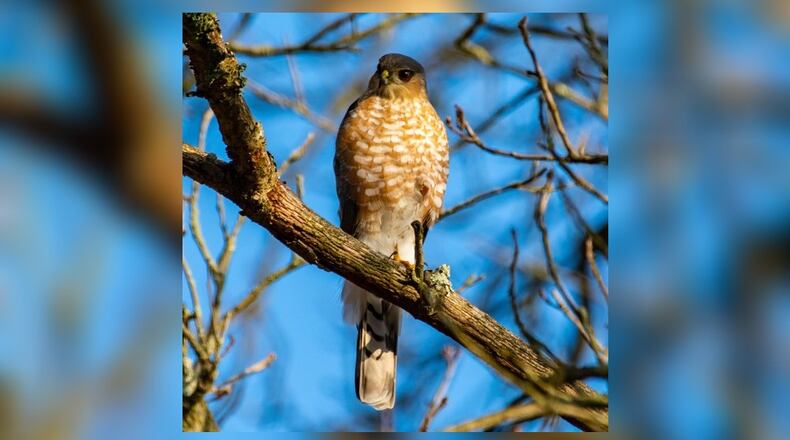From first timers to seasoned bird watchers, there are plenty of opportunities to have fun and learn something new.
One easy way to begin is to take a walk at a local park, and explore all the sights and sounds around you.
Many community members place bird feeders in their yard’s year around, attracting birds in winter months when food is scarce.
What to know
“Any living bird that we see, it doesn’t matter what season it is, whether it’s summer or winter, is a survivor. In the winter, it’s even more difficult to survive in the wild without someone taking care of you. So, we can break out winter birds up into resident or non-resident species,” said Lara Askill, program manager at MetroParks of Butler County.
Resident birds always need to stay fed, warm and dry.
If they stay here during the winter, year-round, they have to tolerate, and adapt. If they leave after the breeding season, which would be late spring, summer, early fall, they migrate.
“That’s a simple, basic way to split up our birds,” Askill said. “A common misnomer is birds migrate because they get cold, but that’s actually not true. If you think about it, whether they are with us year-round, or not, all of our birds have feathers. So, it’s not because they get cold, it’s primarily because of their lack of food.”
For example, everybody loves the Ruby-throated hummingbird. We know they are not here in the winter, they are only here during the breeding season, and that’s because our hummingbirds drink nectar, and they eat Arthropods or insects, she said.
“Here in Southwestern Ohio, in the winter, we don’t have flowers growing and insects flying around,” Askill said. “So, they can’t adapt, or they don’t, so they migrate. We would consider the Ruby-throated hummingbird a non-resident bird in the wintertime, but we do have a lot of resident birds that are with us all year around, and that’s primarily because they are able to adapt, and they can tolerate our winters.”
Winter birds to view
She said some common species birders might see are the black and white woodpecker called the Downy Woodpecker. It’s fairly common for those who like to put out bird feeders and suet in the wintertime.
“We see them all over our MetroParks in Butler County. That’s a year around resident. Woodpeckers eat insects during most of their lives when they are here in Butler County, but they can’t do that in the wintertime, so they have to completely adapt their diets. Instead of eating insects in the wintertime, they have to eat seeds and berries that we have in the forests and grasslands. That’s an example of one of our common winter birds that has to adapt,” Askill said.
Other year-round residents that people might see if they come out to MetroParks include the common, beautiful colored Blue Jay, the red and black Northern Cardinals as well as the White-Breasted Nuthatch, and those are the birds that look like they are wearing tuxedos, and they go up and down the trees and honk.
“The White-Breasted Nuthatch is a fun one for beginning birders, and people who like to go out in the winter, because you can usually hear them before you can see them, but one of the good things about birding in the winter time is you don’t have to compete with the leaves on the trees,” she said.
“So, to me, it’s easier to find birds in the wintertime than it is in the summer, because a lot of times, they are hiding in the trees. They are either in their nests, or they are being quiet because they are sitting on the nest, and they don’t talk once they’ve had their eggs. So, that’s a big difference between winter birding and summer birding,” Askill said.
As far as non-residents, there are birds that only come here in the winter. They are not with us for the rest of the year.
“That’s very exciting, because unless you travel to other places, or the bird’s breeding areas, you might not see these birds, except for in the winter here in Butler County. The majority of those birds are birds that live up North,” she said.
“They live in the artic, or Canada, and that’s where they have their babies, and live for the most of their lives. Those winters are way worse than the winters we have, so they think our winter is mild, and that’s why they come down here,” said Askill.
Affectionately, we call them the “snowbirds,” similarly to what we call people who go to Florida during the winter months, she said.
“You can always tell when winter is coming, if it hasn’t started snowing, when you see these birds,” Askill said.
Some examples of non-resident birds include Dark-Eyed Juncos, and many different species of Sparrows.
“This is a good time of the year for birders to learn about Sparrows. Those are difficult for people because they are all what we call ‘little brown birds.’ However, there are White-Throated Sparrows, and White-Crowned Sparrows. Those are beautiful birds,” she said.
“We have an owl that comes to Southwestern Ohio in the winter called the Northern Saw-whet Owl. He is smaller than an Eastern Screech Owl. The Northern Saw-whet Owl is a tiny owl. I know they’ve been noticing at Voice of America MetroPark, and some of our other parks that have a lot of roads, grasslands and fields, you’ll see Horned Larks, and the Longspurs, and Snow Buntings will come along the edge of the snow, along the roads, and that’s a good time to see them,” Askill said.
How to Participate
Outings at local parks give residents a chance to experience birds, owls, and nature firsthand.
There are two Nature in a Blink: Owl Prowl programs coming up at Governor Bebb MetroPark from 6:30 to 8 p.m., Feb. 7 and Feb. 15 with naturalists from MetroParks.
“We will introduce birds of prey, because owls are birds of prey, and talk about the different species we have in Butler County, Ohio. Then, we actually go out into the woods, and we practice calling the owls. So, we teach everybody how to make a couple of different owl calls. If we are lucky, the owl will respond back to us, or because it is breeding season for the owls in February, we’ll get an opportunity to hear their mating calls,” Askill said.
Participants will learn about the adaptations that make owls incredible nocturnal hunters as they venture out and try to find them. The session will teach attendees how to look and listen for owls. These programs are suited for families and individuals of all ages. For more information, and to register, go to https://reservations.yourmetroparks.net/programs/3623/. The cost is $3 per person. Children ages 2 and under are free.
In partnership with MetroParks, there will also be an Owl Prowl program at Harbin Park in Fairfield from 6:30 p.m. to 7:30 p.m. on Feb. 4.
With winter birding, there are also Irruptive birds, which normally don’t come to Southwestern Ohio, but they will if there’s not enough prey or food for them up North.
A few years ago, someone spotted a Snowy Owl along Interstate 75. It showed up on a traffic camera. That’s one example of an Irruptive species.
Recently at Voice of America MetroPark, a Long-Tailed Duck was spotted, which is definitely a Northern bird. It’s an example of a vagrant bird. Vagrant birds are found outside their normal range, far from where they are usually expected to be seen.
“The Long-Tailed Duck is pretty awesome to be able to see.” Askill said. “It will migrate South, but it doesn’t typically come to Butler County. The very Northern/Eastern part of Ohio is where it would normally migrate to, so, when we have birds that aren’t supposed to be here, a lot of times, they get knocked off or lost because of storms, and we’ve had several big storms over the last three months or so.”
Where to go
MetroParks of Butler County has two “Important Bird Areas or IBA Parks,” designated by the National Audubon Society. Voice of America MetroPark and Gilmore Ponds MetroPark have been designated as Important Bird Areas.
Askill’s recommended birding sites include Governor Bebb MetroPark, Indian Creek MetroPark, Gilmore Ponds MetroPark, and the Forest Run MetroPark.
MORE RESOURCES
“You don’t have to spend a lot of money to go birding. You don’t have to have binoculars, or a fancy telescope. You don’t have to have anything. You can get free bird guides from the Ohio Department of Natural Resources,” Askill said.
Download a free bird guide at www.ohiodnr.gov.
“We host birding programs all year round at MetroParks of Butler County for adults and children,” Askill said. “It’s an easy family activity, or you can do it by yourself.”
Citizen Science Projects like the Great Backyard Bird Count, www.birdcount.org, also encourages students and families to get outside and start birding. There will be a Global Bird Count on Feb. 14-17.
About the Author

